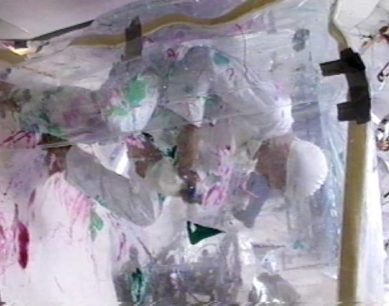Frank Pietronigro – « Drift Painting » in Microgravity – 2003
Artist
First publication symposium Visibility – Legibility of Space Art. Art and Zero G. : the experience of parabolic flights, in collaboration with the @rt Outsiders festival, Paris, 2003.
On April 4, 1998, I flew from the NASA Johnson Space Center, aboard a KC135 turbojet, to create ‘drift paintings’ as my body floated within the 3-D kinetic painting space facilitated by parabolic flight. NASA’s jet flew 42 parabolas, diving between 34,000 and 24,000 feet, resulting in 18 to 25 seconds of weightlessness during which time I painted by squeezing rainbow colored acrylic paints from pastry bags into the space surrounding my body.
When I first wrote about my idea in 1974, I was not planning to work on a parabolic flight. Being a product of the 1950’s science fiction mind-set, I searched for zero-gravity chambers, which I soon discovered were only a figment of someone’s imagination. I needed to bridge the sensibility of the artist with the technology of space flight to find a solution to my desire to paint in zero-gravity. My aesthetic choices dictated the site for my painting rather than the fantastic nature of parabolic flight compelling me to her amusements.
The day before my flight, I tethered a creativity chamber, in which I would paint, to the interior of the jet. I created a vocabulary to identify my techniques: 3D Spacing – All Four Quadrants; The Cocoon; Handwriting; Free Float Ovals; Baseline Pastry Bags Without Magnets; Extension With Magnets, and DNA. I filled pastry bags with acrylic gel medium and marked them with codes to identify content. These pastry bags were used rather than brushes to project paint into space because I was not painting on any support and I needed to project the paint out into the space rather than apply it on a surface.
As a gay man, I found great humor in associating these ‘decorative tools’ with high art and space flight technology. I specifically wore ‘worker boots’ to symbolize my concern for class and ownership issues relevant to accessing such technologies. I attached magnetic loadstones to ‘wands’ and planned to use magnetism to help move the floating paint in space; but I also used it to reference magicians and the beginnings of space travel in alchemy. I mixed diamond dust into my paints to reference Diamond Dust Shoes by Andy Warhol. Like Merlin, I wished that something magic might unfold within the space.
It was my intention to have weightlessness contribute to the organic development of ‘drift paintings’ with spontaneity and serendipity orchestrating the result. I mirrored earlier modernist conventions by employing abstract expressionists’ techniques. I coined the term ‘drift painting’ to reference the Situationists.
I write and wonder what meaning my experience offers. How does this sign of an artist floating, unfixed, always drifting, body submersed in his painting, sweating and vomiting in a creativity chamber aboard a jet, serve all involved, including myself? My intention as author was to also experience the work as audience with signifiers and my interpretation of them constantly shifting. I considered this experience as a return to my mother’s womb and felt like I was drifting on soft moving currents of warm water. I saw the jet as the Phallus in which my mother’s embryonic sack was contained and I was at play satisfying my desires. Symbols in my painting were adrift, my point of view was no longer anchored and linear perspective was abandoned. The painting was not relegated to a static two-dimensional surface and as a result there was an infinite number of compositions happening simultaneously, each in accordance to all points of view from which the work could be interpreted, in support of heterogeneity.
During the flight I meditated, danced, drew and experienced motion sickness as I painted. Equipped with my motion sickness bags, swim cap and goggles, everything floated around me as I experienced various forms of spatial disorientation. The evolution of the forms was unexpectedly ethereal. The paint and I floated in what I remember as slow motion. Every action was elementary with little control over the outcome; yet, I began to understand some things about this working space. It felt like the boundaries of my body disappeared and feelings of physical expansion facilitated a shift in consciousness.
Jouissance graced me when I realized that I could not get out of the chamber despite needing fresh air. I felt asphyxiated, covered in paint and knew that I would imprint myself on the jet’s interior, like the cave paintings, if I escaped. Suddenly, a sense of awe transformed this spectacle into the sublime. There I was, battered by a jet, feeling humbled and wounded by this passage, reflecting on our potlatch and sensing the sacrifice of making such art. I felt sick, exhausted, thirsty and grateful. My experimentation was over. Still there remained what I discovered the first time I saw the KC-135, a wonderful sense of the mystical.

© Frank Pietronigro & Leonardo/Olats, October 2003, republished 2023
Leonardo/Olats
Observatoire Leonardo des Arts et des Techno-Sciences
À propos / About | Lettre d'information Olats News



Pour toute (re)publication, merci de contacter / For any (re)publication, please contact Annick Bureaud: info@olats.org
Pour toute question concernant le site, merci de contacter / For any issue about the website, please contact: webmaster@olats.org
Design Thierry Fournier
© Association Leonardo 1997-2022